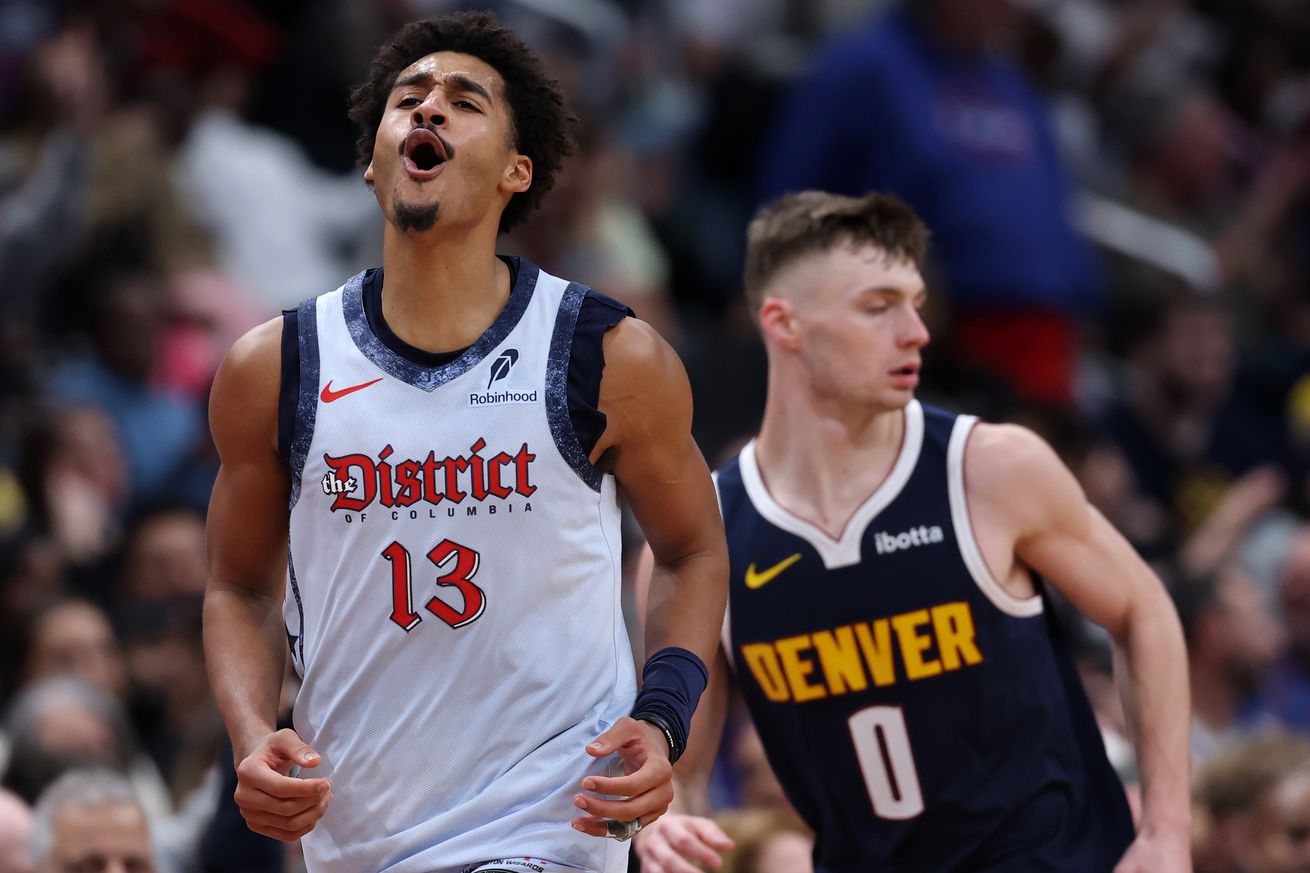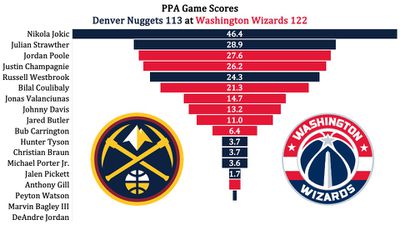
Stats, analysis, commentary.
Despite missing five rotation players, the Washington Wizards out-fought Nikola Jokic and the Denver Nuggets to snap the losing streak at 16.
One factor stood out during and after the game: Washington was +33 from the three point line. The Nuggets are dead last in three-point attempt rate but generally shoot the three well when they take them. Last night: 5-24 from deep to the Wizards’ 16-41.
After a careless start to the game (7 turnovers in the first quarter and 5 more in the second), Denver took better care of the ball and finished the game with just 15 miscues to Washington’s 17. Offensive rebounding was basically a draw, as were free throws (though the Nuggets committed almost twice as many fouls — 23-12).
The key to Washington’s victory was shooting — 57.0% effective field goal percentage for the Wizards to 51.6% for Denver, even though the Nuggets largely had their way inside. Denver’s inability to knock down open looks from the three-point line was a serious drag on their offensive performance.
Bright spots?
- Jordan Poole provided offensive punch, pouring in 39 points and a career high nine threes.
- Jokic, the three-time NBA Most Valuable Player (it should be four-time, and very well might be at the end of this season) was excellent — a career-high 56 points, as well as 16 rebounds and 8 assists. As great as he was, his 126 offensive rating (points produced per possession x 100) lowered his efficiency for the season. He entered the game with a 130 ortg.
- Starting in place of an array of injured teammates, Justin Champagnie played the best game of his NBA career — 23 points (on 9-13 shooting), 8 rebounds, 2 steals and 2 blocks.
- Bilal Coulibaly had another terrible offensive game — 6 points on 2-9 shooting, 0-3 from three-point range, and an anemic 10.9% usage rate, and yet, he finished with an above average PPA (see below) because of his rebounding and disruptive defense — 6 rebounds (4 on the offensive glass), 5 assists, 4 steals and 3 blocks. One of those blocks was a volleyball spike in the closing minutes that cemented Washington’s victory.
- Jonas Valanciunas got thoroughly outplayed by Jokic, but he at least made his Serbian counterpart fight for it. Valanciunas had 20 points, 12 rebounds, 5 assists, and 5 blocks. His overall efficiency was meh (108 ortg) because of ho-hum 8-15 shooting and 5 turnovers.
- Just back from a one-game G League assignment, Johnny Davis made his 13 minutes of NBA action count — 7 points on 3-4 shooting, 3 rebounds, an assist, 2 steals and a block. The Wizards were +12 in his time on the court.
- Jared Butler made the most of his 17 mintues — 12 points on 5-9 shooting, including a pair of threes, 2 rebounds, and 4 assists.
- Neither Bub Carrington nor Anthony Gill could be reasonably accused of playing well, but each made a few plays that helped the team win.
- Marvin Bagley III got obliterated by Jokic, yet still contributed a couple rebounds, an assist, a steal and a block.
Negatives? We’ll save those for a day when they didn’t just break a 16-game losing streak and earn their third win of the season.
Four Factors
Below are the four factors that decide wins and losses in basketball — shooting (efg), rebounding (offensive rebounds), ball handling (turnovers), fouling (free throws made).
Stats & Metrics
Below are a few performance metrics, including the Player Production Average (PPA) Game Score. PPA is my overall production metric, which credits players for things they do that help a team win (scoring, rebounding, playmaking, defending) and dings them for things that hurt (missed shots, turnovers, bad defense, fouls).
Game Score (GmSC) converts individual production into points on the scoreboard. The scale is the same as points and reflects each player’s total contributions for the game. The lowest possible GmSC is zero.
PPA is a per possession metric designed for larger data sets. In small sample sizes, the numbers can get weird. In PPA, 100 is average, higher is better and replacement level is 45. For a single game, replacement level isn’t much use, and I reiterate the caution about small samples sometimes producing weird results.
POSS is the number of possessions each player was on the floor in this game.
ORTG = offensive rating, which is points produced per individual possessions x 100. League average last season was 114.8. Points produced is not the same as points scored. It includes the value of assists and offensive rebounds, as well as sharing credit when receiving an assist.
USG = offensive usage rate. Average is 20%.
ORTG and USG are versions of stats created by former Wizards assistant coach Dean Oliver and modified by me. ORTG is an efficiency measure that accounts for the value of shooting, offensive rebounds, assists and turnovers. USG includes shooting from the floor and free throw line, offensive rebounds, assists and turnovers.
+PTS = “Plus Points” is a measure of the points gained or lost by each player based on their efficiency in this game compared to league average efficiency on the same number of possessions. A player with an offensive rating (points produced per possession x 100) of 100 who uses 20 possessions would produce 20 points. If the league average efficiency is 114, the league — on average — would produced 22.8 points in the same 20 possessions. So, the player in this hypothetical would have a +PTS score of -2.8.

